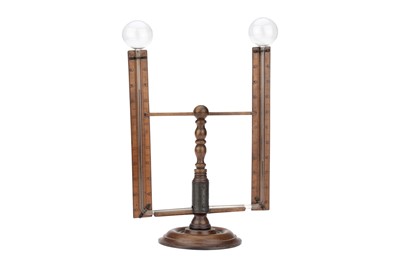24th May, 2023 12:00
Fine Instruments of Science, Medicine and Books
A Rare & Early Differential Thermometer or Rumford Thermoscope
English, first quarter of the 19th century, signed to the rear of each boxwood thermometer scale 'WATKINS & HILL 5 CHARING CROSS LONDON' the thermometer on turned mahogany base with turned wooden column supporting the delicate glass 'U' shaped tube, the scales both running 50 - 0 - 50 , height 37cm
The differential air thermometer, also known as the Rumford thermoscope, is an instrument used to measure temperature by utilizing the expansion and contraction of air with changes in temperature. This instrument has a long history, dating back to the 18th century.
The thermometer was first developed by Benjamin Thompson, who later became known as Count Rumford, in the late 1700s. Rumford was an American-born physicist and inventor who worked in Europe during the late 18th and early 19th centuries. He was interested in the nature of heat and the ways in which it could be measured.
The Rumford thermoscope consists of two identical glass bulbs connected by a narrow glass tube. One of the bulbs is filled with air and the other is evacuated. The two bulbs are attached to a wooden frame, which provides stability for the instrument.
When the thermometer is exposed to a change in temperature, the air in the bulb expands or contracts, causing the liquid in the tube to move. The level of the liquid in the tube indicates the temperature difference between the two bulbs. By carefully calibrating the instrument, it is possible to obtain accurate temperature measurements.
The differential air thermometer was an important development in the field of temperature measurement, as it allowed for more precise measurements than previous methods. It was also relatively inexpensive and easy to use, making it accessible to a wider range of scientists and researchers.
In the early 19th century, other types of thermometers, such as the mercury thermometer, began to be developed. These instruments were more accurate and easier to use than the Rumford thermoscope, and eventually became the standard for temperature measurement.
However, the differential air thermometer remains an important historical artifact and a testament to the ingenuity of early scientists and inventors. Today, it is still possible to find examples of this instrument in museums and collections around the world.
Note: due to the delicate nature of this instrument Flints are unable to ship it. please contact Newbury Pack & Send for a quote for postage
Sold for £562
Result plus buyers premium
English, first quarter of the 19th century, signed to the rear of each boxwood thermometer scale 'WATKINS & HILL 5 CHARING CROSS LONDON' the thermometer on turned mahogany base with turned wooden column supporting the delicate glass 'U' shaped tube, the scales both running 50 - 0 - 50 , height 37cm
The differential air thermometer, also known as the Rumford thermoscope, is an instrument used to measure temperature by utilizing the expansion and contraction of air with changes in temperature. This instrument has a long history, dating back to the 18th century.
The thermometer was first developed by Benjamin Thompson, who later became known as Count Rumford, in the late 1700s. Rumford was an American-born physicist and inventor who worked in Europe during the late 18th and early 19th centuries. He was interested in the nature of heat and the ways in which it could be measured.
The Rumford thermoscope consists of two identical glass bulbs connected by a narrow glass tube. One of the bulbs is filled with air and the other is evacuated. The two bulbs are attached to a wooden frame, which provides stability for the instrument.
When the thermometer is exposed to a change in temperature, the air in the bulb expands or contracts, causing the liquid in the tube to move. The level of the liquid in the tube indicates the temperature difference between the two bulbs. By carefully calibrating the instrument, it is possible to obtain accurate temperature measurements.
The differential air thermometer was an important development in the field of temperature measurement, as it allowed for more precise measurements than previous methods. It was also relatively inexpensive and easy to use, making it accessible to a wider range of scientists and researchers.
In the early 19th century, other types of thermometers, such as the mercury thermometer, began to be developed. These instruments were more accurate and easier to use than the Rumford thermoscope, and eventually became the standard for temperature measurement.
However, the differential air thermometer remains an important historical artifact and a testament to the ingenuity of early scientists and inventors. Today, it is still possible to find examples of this instrument in museums and collections around the world.
Note: due to the delicate nature of this instrument Flints are unable to ship it. please contact Newbury Pack & Send for a quote for postage






